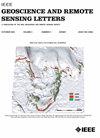基于高分辨率遥感数据的城市渠系水体叶绿素估算
IF 4
3区 地球科学
Q2 ENGINEERING, ELECTRICAL & ELECTRONIC
引用次数: 1
摘要
水质是与大规模运河运营和管理有关的一个关键问题,很容易受到短期天气变化和人为活动的影响。叶绿素是衡量水渠系统水质和饮用灌溉可用性的关键指标之一。然而,先前的研究设计了使用中分辨率遥感数据(例如Landsat)估算水叶绿素的最先进算法,这些数据的分辨率不足以捕获通常比此类数据中一个像素更窄的运河。覆盖整个运河网络的高分辨率图像可能只包括可见波段(即红、绿、蓝波段),或者花费数千美元进行实时水叶绿素监测的有效调查。因此,设计用于运河水叶绿素分析的策略应考虑空间分辨率、有助于叶绿素检测的光谱和经济负担之间的适当权衡。这封信介绍了我们在确定和评估测量运河水域叶绿素度的行星数据范围方面所做的努力。实验表明,虽然Planet可以代表水体叶绿素浓度的相对变化,但要准确地得到渠系水体叶绿素浓度变化的结果,仍然需要新的算法。本文章由计算机程序翻译,如有差异,请以英文原文为准。
Water Chlorophyll Estimation in an Urban Canal System With High-Resolution Remote Sensing Data
Water quality, which is a key concern associated with large-scale canal operation and management, is vulnerable to the influences from short-term weather variations and artificial activities. Chlorophyll is one of the key indicators to measure the water quality and usability for drinking and irrigation in the canal system. However, previous research designed the state-of-the-art algorithms regarding water chlorophyll estimation using medium-resolution remote sensing data (e.g., Landsat), which has insufficient resolution to capture canals that are usually narrower than one pixel in such data. High-resolution imageries covering the whole canal network might include only either visible wavebands (i.e., red, green, blue bands) or cost thousands of dollars for an effective investigation on real-time water chlorophyll monitoring. Thus, the strategy designed for water chlorophyll analysis in a canal should consider an appropriate tradeoff among spatial resolution, the spectrum helpful for chlorophyll detection, and the financial burden. This letter presents our efforts on identifying and assessing the extent of the Planet data for measuring chlorophyll degree of canal waters. The experiments show that although Planet can represent the relative variation in water chlorophyll concentration, new algorithms are still necessary for accurate results regarding water chlorophyll variations in a canal system.
求助全文
通过发布文献求助,成功后即可免费获取论文全文。
去求助
来源期刊

IEEE Geoscience and Remote Sensing Letters
工程技术-地球化学与地球物理
CiteScore
7.60
自引率
12.50%
发文量
1113
审稿时长
3.4 months
期刊介绍:
IEEE Geoscience and Remote Sensing Letters (GRSL) is a monthly publication for short papers (maximum length 5 pages) addressing new ideas and formative concepts in remote sensing as well as important new and timely results and concepts. Papers should relate to the theory, concepts and techniques of science and engineering as applied to sensing the earth, oceans, atmosphere, and space, and the processing, interpretation, and dissemination of this information. The technical content of papers must be both new and significant. Experimental data must be complete and include sufficient description of experimental apparatus, methods, and relevant experimental conditions. GRSL encourages the incorporation of "extended objects" or "multimedia" such as animations to enhance the shorter papers.
 求助内容:
求助内容: 应助结果提醒方式:
应助结果提醒方式:


